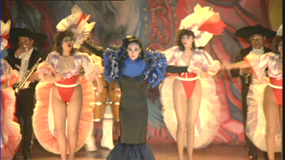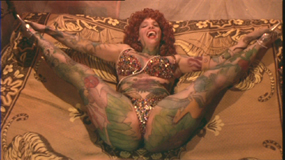|
Newest Reviews:
New Movies -
The Tunnel
V/H/S
The Tall Man
Mama Africa
Detention
Brake
Ted
Tomboy
Brownian Movement
Last Ride
[Rec]³: Genesis
Hara-Kiri: Death of a Samurai
Indie Game: The Movie
Abraham Lincoln: Vampire Hunter
Old Movies -
Touki Bouki: The Journey of the Hyena
Drums Along the Mohawk
The Chase
The Heiress
Show
People
The Strange Affair of Uncle Harry
Pitfall
Driftwood
Miracle Mile
The Great Flamarion
Dark Habits
Archives -
Recap: 2000,
2001, 2002,
2003, 2004
, 2005, 2006,
2007 , 2008
, 2009 ,
2010 , 2011 ,
2012
All reviews alphabetically
All reviews by star rating
All reviews by release year
Masterpieces
Screening Log
Links
FAQ
E-mail me
HOME
| |
Santa Sangre (Alejandro Jodorowsky, 1989)
 One must approach Alejandro
Jodorowsky’s Santa Sangre without much anticipation of cinematic
normality, or else it might prove a baffling experience. In this visually
exciting romp, Jodorowsky tosses in so much left-field surrealism that his movie
ends up detaching itself from reality well before the film makes that break an
explicit selling point. Compared to this hallucinatory barrage, even the films
of a fantasist such as Tim Burton seem positively mundane. It’s not really
that Jodorowsky is an incredibly skilled, or at least consistently skilled,
filmmaker so much as that he’s not afraid to take the audiences to a place
where explanations won’t be granted. Even if the plot, when summarized, can be
reduced to a familiar tale (echoes of Psycho can be found throughout),
the details here are juxtaposed with one another in a manner that demands the
viewer not rely on any expectations of past films seen. Jodorowsky’s vision
here is certainly singular, even as it recalls Bunuel, Fellini, Hitchcock, James
Whale, the German Expressionists and a multitude of other master filmmakers. Santa
Sangre is cobbled together from parts, in the best possible way. One must approach Alejandro
Jodorowsky’s Santa Sangre without much anticipation of cinematic
normality, or else it might prove a baffling experience. In this visually
exciting romp, Jodorowsky tosses in so much left-field surrealism that his movie
ends up detaching itself from reality well before the film makes that break an
explicit selling point. Compared to this hallucinatory barrage, even the films
of a fantasist such as Tim Burton seem positively mundane. It’s not really
that Jodorowsky is an incredibly skilled, or at least consistently skilled,
filmmaker so much as that he’s not afraid to take the audiences to a place
where explanations won’t be granted. Even if the plot, when summarized, can be
reduced to a familiar tale (echoes of Psycho can be found throughout),
the details here are juxtaposed with one another in a manner that demands the
viewer not rely on any expectations of past films seen. Jodorowsky’s vision
here is certainly singular, even as it recalls Bunuel, Fellini, Hitchcock, James
Whale, the German Expressionists and a multitude of other master filmmakers. Santa
Sangre is cobbled together from parts, in the best possible way.
 Religious guilt, crippling Freudian
impulses, social status, and the majority’s arbitrary definition of madness
all conspire together to form a repressive enclosure for the protagonist, yet
the film he’s in seems to gleefully trample over any limiting mores. What Santa
Sangre is, above all else, is a presentation of one man’s wild psyche. His
obsessions are turned loose upon the world, with nary a limitation, resulting in
a phantasmagoric parade of suggestive, psychologically loaded images.
Knife-murders, circus freaks, insane asylums, and a hero that spends a good
portion of the movie thinking he’s a hawk, collectively make the film an
experience that simultaneously revolts, challenges, amuses and satirizes the
audience. When the camera lingers too long on a Downs Syndrome-stricken face or
a bleeding knife wound, it’s obviously a confrontation, but of a kind that few
moviemakers outside of Werner Herzog would attempt. This willingness to go where
few other filmmakers tread undeniably qualifies Jodorowsky as a visionary of
sorts, but the film’s quality is mildly erratic. For example, a sequence that
almost qualifies as a musical number occurs about forty minutes in, when a pimp
guides a group of mental patients down a street in a red light district. It’s
an incredibly strong sequence, but it’s lamentable that as good as the film
is, it doesn’t often reach the same dizzying heights. Practically no feature
film has sustained such a pitch for an entire runtime, however, so quibbling
about such matters seems somewhat absurd. Perhaps more troubling, though is that
the comparatively conventional third act felt at once like a disappointment and
a relief (it will be interesting to see how future viewings alter this view, in
any case). The conclusion provides an unlikely, but welcome burst of humanist
concern, that tones down any earlier charges of exploitation. On the other hand,
however, since there are so few exploitation films that go this far, is that a
positive thing? Religious guilt, crippling Freudian
impulses, social status, and the majority’s arbitrary definition of madness
all conspire together to form a repressive enclosure for the protagonist, yet
the film he’s in seems to gleefully trample over any limiting mores. What Santa
Sangre is, above all else, is a presentation of one man’s wild psyche. His
obsessions are turned loose upon the world, with nary a limitation, resulting in
a phantasmagoric parade of suggestive, psychologically loaded images.
Knife-murders, circus freaks, insane asylums, and a hero that spends a good
portion of the movie thinking he’s a hawk, collectively make the film an
experience that simultaneously revolts, challenges, amuses and satirizes the
audience. When the camera lingers too long on a Downs Syndrome-stricken face or
a bleeding knife wound, it’s obviously a confrontation, but of a kind that few
moviemakers outside of Werner Herzog would attempt. This willingness to go where
few other filmmakers tread undeniably qualifies Jodorowsky as a visionary of
sorts, but the film’s quality is mildly erratic. For example, a sequence that
almost qualifies as a musical number occurs about forty minutes in, when a pimp
guides a group of mental patients down a street in a red light district. It’s
an incredibly strong sequence, but it’s lamentable that as good as the film
is, it doesn’t often reach the same dizzying heights. Practically no feature
film has sustained such a pitch for an entire runtime, however, so quibbling
about such matters seems somewhat absurd. Perhaps more troubling, though is that
the comparatively conventional third act felt at once like a disappointment and
a relief (it will be interesting to see how future viewings alter this view, in
any case). The conclusion provides an unlikely, but welcome burst of humanist
concern, that tones down any earlier charges of exploitation. On the other hand,
however, since there are so few exploitation films that go this far, is that a
positive thing?
78
04-01-04
Jeremy Heilman
|